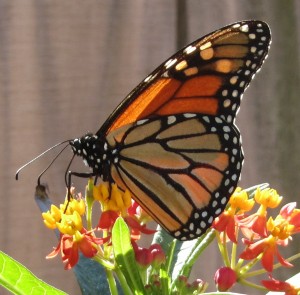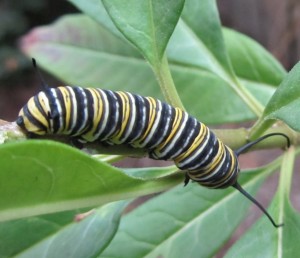Double GM Whammy for the Monarch Butterfly
 I love butterflies, although I’ve always thought they should be called flutterbys. I photographed this monarch butterfly feeding on milkweed in our backyard garden. It is glorious and flies in a marvelously floating way that supports its name monarch. It may be the most popular and best known butterfly in the world. Tourists follow their migrations and visit their wintering sites in Mexico. Since monarch butterfly larvae feed exclusively upon milkweed, gardeners plant milkweed to attract the butterflies and help them on their migration journey. For thousands of years these beautiful butterflies and their milkweed plants have lived well alongside our farms and fields, but their numbers are steadily decreasing. Our heavy reliance on GM crops, their toxins, and herbicides could be dooming the monarch. They are being attacked in two ways: the destruction of the milkweed their larvae exclusively feed upon and the direct poisoning of the larvae.
I love butterflies, although I’ve always thought they should be called flutterbys. I photographed this monarch butterfly feeding on milkweed in our backyard garden. It is glorious and flies in a marvelously floating way that supports its name monarch. It may be the most popular and best known butterfly in the world. Tourists follow their migrations and visit their wintering sites in Mexico. Since monarch butterfly larvae feed exclusively upon milkweed, gardeners plant milkweed to attract the butterflies and help them on their migration journey. For thousands of years these beautiful butterflies and their milkweed plants have lived well alongside our farms and fields, but their numbers are steadily decreasing. Our heavy reliance on GM crops, their toxins, and herbicides could be dooming the monarch. They are being attacked in two ways: the destruction of the milkweed their larvae exclusively feed upon and the direct poisoning of the larvae.
There are fewer monarch butterflies. A recent study of the area in Mexico occupied by wintering monarch butterflies found a statistically significant decrease in the numbers of butterflies in 2009-2010. The numbers were at an all-time low, following a 15-year downward trend. Although the winter of 2010-11 saw an increase, the total remained low. The study proposed three factors contributing to the decline in monarch butterflies: (1) degradation of the wintering forests in Mexico (2) “loss of breeding habitat in the United States due to the expansion of GM herbicide-resistant crops, with consequent loss of milkweed host plants, as well as continued land deveopment;” and (3) severe weather. The study questions the long-term survival of the monarch butterfly and its migration.
Research by Bob Hartzler of Iowa State University found that numbers of milkweed plants declined following the introduction of Roundup Ready crops. Roundup Ready crops are genetically engineered to be resistant to herbicides, specifically glyphosate. Another study published in the journal Insect Conservation and Diversity also shows that the increased use of glyphosate herbicide is killing milkweed plants. Milkweed has been shown to be very susceptible to glyphosate, the herbicide in Roundup. Roundup Ready seeds are genetically engineered to be resistant to glyphosate, so that the crops will survive the application of the herbicide–only the weeds will be killed. However, milkweed is not resistant so that the use of glyphosate on Roundup Ready GM crops kills the milkweed in and around crop fields. In addition, due to increasing resistance of some weeds to glyphosate, glyphosate is now being applied to crops in even larger amounts than initially intended. The widespread use of more glyphosate could escalate the killing of the milkweed.
 Killing the milkweed is not the only way GM crops harm monarchs. They harm the larvae directly. We have lots of monarch larvae feeding on our backyard milkweed plants. A monarch larva is quite attractive–for a caterpillar. They are not spiky and fearsome looking like many caterpillars. They have smooth round bodies, feathery antennae, and are colored in an alternating striped pattern of yellow, black, and white. In addition to killing the host milkweed plants, GM crops also threaten these attractive monarch larvae with their toxicity. Studies by John Losey et al. and Stanley-Horn et al. at Iowa State University show that pollen from Bt corn can kill monarch butterfly larvae. Bt corn has been engineered to contain the Bacillus thuringiensis (Bt) toxin to make corn resistant to the European corn borer. However, since corn is pollinated by wind distribution, the Bt corn pollen can be blown and deposited on milkweed plants commonly found alongside the corn crops and in neighboring fields. In laboratory tests, monarchs fed milkweed leaves dusted with Bt corn pollen “ate less, grew more slowly and suffered a higher mortality rate” than those fed on uncontaminated milkweed leaves. Death occured even at low levels of pollen. Nearly half of the larvae fed on Bt corn pollen died, while all the other larvae survived. The monarchs’ spring northward migration puts them in the cornfields just at the time when corn is shedding pollen. The type of Bt corn used in the tests, 176 Bt corn, was thought to be the most serious threat to monarchs; however, it was expected to be phased out by 2003, and the decline in monarch numbers continues.
Killing the milkweed is not the only way GM crops harm monarchs. They harm the larvae directly. We have lots of monarch larvae feeding on our backyard milkweed plants. A monarch larva is quite attractive–for a caterpillar. They are not spiky and fearsome looking like many caterpillars. They have smooth round bodies, feathery antennae, and are colored in an alternating striped pattern of yellow, black, and white. In addition to killing the host milkweed plants, GM crops also threaten these attractive monarch larvae with their toxicity. Studies by John Losey et al. and Stanley-Horn et al. at Iowa State University show that pollen from Bt corn can kill monarch butterfly larvae. Bt corn has been engineered to contain the Bacillus thuringiensis (Bt) toxin to make corn resistant to the European corn borer. However, since corn is pollinated by wind distribution, the Bt corn pollen can be blown and deposited on milkweed plants commonly found alongside the corn crops and in neighboring fields. In laboratory tests, monarchs fed milkweed leaves dusted with Bt corn pollen “ate less, grew more slowly and suffered a higher mortality rate” than those fed on uncontaminated milkweed leaves. Death occured even at low levels of pollen. Nearly half of the larvae fed on Bt corn pollen died, while all the other larvae survived. The monarchs’ spring northward migration puts them in the cornfields just at the time when corn is shedding pollen. The type of Bt corn used in the tests, 176 Bt corn, was thought to be the most serious threat to monarchs; however, it was expected to be phased out by 2003, and the decline in monarch numbers continues.
Milkweed had never been a significant problem to farmers before GM crops were introduced. Although milkweed was common, it seldom reduced crop yields. Of course, milkweed is not the primary target of the glyphosate in Roundup; it is just one of the many weeds it is intended to kill. In fact, the increasing use of herbicides and other chemicals is causing widespread destruction of not only butterflies, but also wildflowers, and other insects. These wild plants nourish birds and they help fight crop pests by attracting ladybirds and other insects, acting as a natural pesticide and reducing the need for chemicals. If we continue the current agricultural trend of using more and more chemicals on genetically engineered crops how long will we have these beautiful butterflies to enjoy?
Update, July 15, 2012: David Snow, a California garden designer, has been devoting himself to pressuring “the world’s largest maker of pesticides” to change the labels on it “Bug-B-Gon” and “Flower, Fruit and Vegetable Insect Killer” to remove the images of the monarch butterfly caterpillar. He had called the manufacturer, Ortho (parent company is Scotts Co. LLC), and filed formal complaints. Snow just wanted Ortho to replace the monarch caterpillar images with “a certified bad-guy bug.” Snow’s campaign was successful; he was notified in early July that Ortho is changing the labels.
The monarch caterpillar feeds exclusively on the milkweed plant, which means they are harmless to home garden plants. The numbers of monarch butterflies in California have fallen by an estimated 80% over the last 15 years.
Source: http://www.mercurynews.com/breaking-news/ci_21044136/victory-getting-caterpillar-off-pesticide-label
Update, December 6, 2012: A new study has shown that “Roundup is killing off the milkweed on which the monarchs lay their eggs, and sprawl and recent droughts threaten the milkweed as well. If that weren’t enough, monarchs are losing a grip on the 60-square-mile area where they winter in Mexico.” “Will the devastated monarch butterfly take flight again?”
Update, March 14, 2013: Sad News! A survey in Mexico in December 2012 and January 2013 found a 59% decrease in wintering monarch colonies. Scientists said the likely cause is unseasonably warm weather and a “dramatic loss of habitat in the U.S. Corn Belt.” “Mexico monarch butterfly population smallest in years, study says.”
Update, May 19, 2014: Here’s How You Can Help Bring Monarch Butterflies (and Honey Bees) Back from the Brink of Extinction You can help prevent the extinction by planting milkweed and by signing a letter and “the Center for Food Safety’s petition, urging the Environmental Protection Agency (EPA), US Department of Agriculture (USDA), and President Obama to protect the monarchs’ breeding habitat by halting the approval of Monsanto Roundup Ready™ and other glyphosate-resistant and pesticide-promoting genetically engineered crops.”

Comments
Double GM Whammy for the Monarch Butterfly — No Comments
HTML tags allowed in your comment: <a href="" title=""> <abbr title=""> <acronym title=""> <b> <blockquote cite=""> <cite> <code> <del datetime=""> <em> <i> <q cite=""> <s> <strike> <strong>